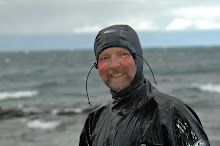
Earler this week the US Coast Guard buoy tender visited Chequamagon Bay and retrieved all the navigation buoys for season. No more 'red right return' until spring I guess. I think this means we are officially supposed to cease paddling for the season, or maybe it just means we need to paddle at our own risk. The buoys are great in heavy traffic areas because you can just stay on the 'wrong' side of them and avoid the motor boats. They also make great reference points since they show up on the charts and are a discrete point, visible for quite a distance. I usually punch them in when I first encounter them in the spring and use them when I time the legs on a crossing, especially if its foggy and you can't see your destination. The one negative thing about the buoys is that they really and truly stink.
All the good that the Coast Guard buoys provide is tempered by their use as a seagull and cormorant crapper. Only a foolish paddler approaches a buoy from downwind. The collection of birds in the photo below were not on a moored buoy but were sitting on Manitou Rock, a pile of rocks that marks the end of the reef that extends off the southwest tip of Manitou Island.
 Its not much of a rock pile but it has a permanent navigation marker in the middle of it. This marker might as well say Waterbird Outhouse - Unisex. You can bet that I shot that image with a telephoto lens from well upwind. Unfortunately, being upwind shields you from the otherworldly odor but is also the preferred take off route for the birds. Don't get too close! The last thing you want is to spook them and have them come cruising over your kayak...and your head of course. While biking with the VOR in Stanley Park in Vancouver, I narrowly missed being strafed by a roosting Double Crested Cormorant sitting on a cliff above the trail. That would have not been good, miles from the hotel. I'm not certain I would have been allowed on the ferry had I suffered a direct hit.
Its not much of a rock pile but it has a permanent navigation marker in the middle of it. This marker might as well say Waterbird Outhouse - Unisex. You can bet that I shot that image with a telephoto lens from well upwind. Unfortunately, being upwind shields you from the otherworldly odor but is also the preferred take off route for the birds. Don't get too close! The last thing you want is to spook them and have them come cruising over your kayak...and your head of course. While biking with the VOR in Stanley Park in Vancouver, I narrowly missed being strafed by a roosting Double Crested Cormorant sitting on a cliff above the trail. That would have not been good, miles from the hotel. I'm not certain I would have been allowed on the ferry had I suffered a direct hit.But the buoys are stored and the cormorants have headed down the Mississippi Flyway to plague the catfish farmers in the southeast US. Since DDT was banned, the Double Crested Cormorant population has exploded, tripling in the last dozen years. I guess the 'balance of nature' is more of a pendulum. Still, its nice to see bird life when you are paddling in the Apostles. I just don't want to smell em'.


1 comment:
So were you up here? Ranger Sue and I stopped to see the Alder Tuesday night when it was docked for the evening in Washburn. Looks even more impressive close up.
And for another perspective on Little Manitou Island, take a look at my blog for today.
Post a Comment